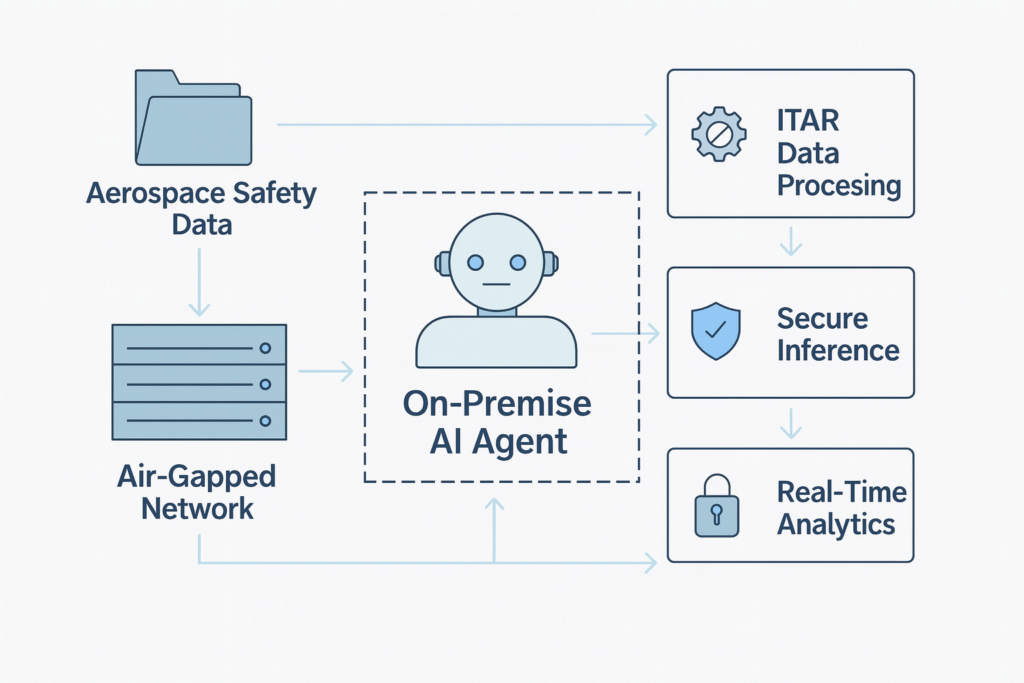The Growing Challenge: AI Meets ITAR
The aerospace and defense industry faces a paradox. While 78% of defense contractors are exploring artificial intelligence, only 23% have achieved ITAR compliance in their deployments.
The issue lies in cloud dependence. Most AI platforms rely on distributed, third-party environments — a direct conflict with International Traffic in Arms Regulations (ITAR), which mandate strict U.S. data sovereignty and zero foreign exposure.
For organizations handling flight control algorithms, missile diagnostics, or weapon system telemetry, data can’t simply be secure — it must remain isolated, controlled, and auditable.
What ITAR Really Means for AI Systems
AI systems in aerospace and defense are classified as defense articles under the U.S. Munitions List (USML), requiring compliance across several domains:
- Data Sovereignty: All information must reside within U.S. jurisdiction — including cache files, models, and backups.
- Access Control: Only verified U.S. persons can operate, maintain, or even view data.
- Export Restrictions: Sharing algorithms or technical data with non-U.S. persons demands State Department licensing — even for remote access.
These constraints make typical cloud-based AI infeasible for safety-critical systems, where milliseconds can separate safety from failure.
The Solution: On-Premise, Air-Gapped AI Agents
Netray’s ITAR-compliant AI architecture is built for air-gapped, on-premise environments — eliminating cloud dependency while delivering real-time intelligence.
Core Design Principles:
- Physical Isolation: No external connectivity or removable media.
- Secure Ingestion: Encrypted data pipelines, digital signatures, and sandbox scanning before entry.
- Network Segmentation: Distinct management, data, and control planes prevent cross-domain breaches.
- Continuous Auditing: Immutable blockchain-based logs ensure traceability for every AI action.
This architecture achieves sub-millisecond inference speeds, 99.99% uptime, and full ITAR alignment across all data layers.
How It Works: Intelligent Processing Without Exposure
- Distributed Edge AI: Local agents process data near sensors to minimize latency and prevent data transfer outside secure boundaries.
- Federated Learning: Models improve collectively without centralizing sensitive data.
- Real-Time Inference: Hardware-accelerated engines analyze flight, radar, or maintenance data instantaneously.
- Automated Compliance Monitoring: AI continuously checks for data lineage, personnel access, and export control compliance.
Together, these capabilities allow aerospace programs to modernize safely — maintaining both mission integrity and regulatory trust.
Proven Aerospace Applications
- Flight Safety Systems
AI agents analyze aircraft sensor data to predict failures, optimize maintenance, and monitor pilot workload — all within secure, offline networks.
→ Result: 34% fewer unscheduled maintenance events and 28% higher mission readiness. - Weapon System Diagnostics
Defense AI agents provide real-time performance and anomaly detection for guided systems and launch platforms.
→ Result: 95% faster fault identification and safer operational cycles. - Manufacturing & Quality Assurance
AI-driven defect detection and process optimization deliver higher precision and audit-ready traceability.
→ Result: 40% improvement in inspection accuracy and 25% reduction in rework costs.
Built for Compliance, Designed for Performance
Netray’s ITAR-compliant AI framework ensures full alignment with aerospace and defense standards including:
- DO-178C (software safety assurance)
- AS9100 (aerospace quality management)
- NIST SP 800-171 and CMMC Level 3 (cybersecurity compliance)
With continuous monitoring, explainable AI modules, and human oversight, these systems offer both transparency and trust — essential for certification and mission-critical deployment.
Implementation Roadmap
- Phase 1 – Assessment: Map existing data systems, security layers, and compliance gaps.
- Phase 2 – Pilot Deployment: Install AI agents in a controlled, air-gapped testbed.
- Phase 3 – Scale: Expand to full production, integrating predictive analytics and continuous compliance monitoring.
e future of aerospace safety depends on AI — but not at the expense of compliance.
ITAR-compliant AI agents enable defense organizations to gain real-time intelligence, predictive capabilities, and operational resilience without ever exposing data beyond secure U.S. borders.
Netray’s on-premise AI deployments redefine what’s possible: high-speed analytics, zero cloud dependency, and uncompromising ITAR adherence.



